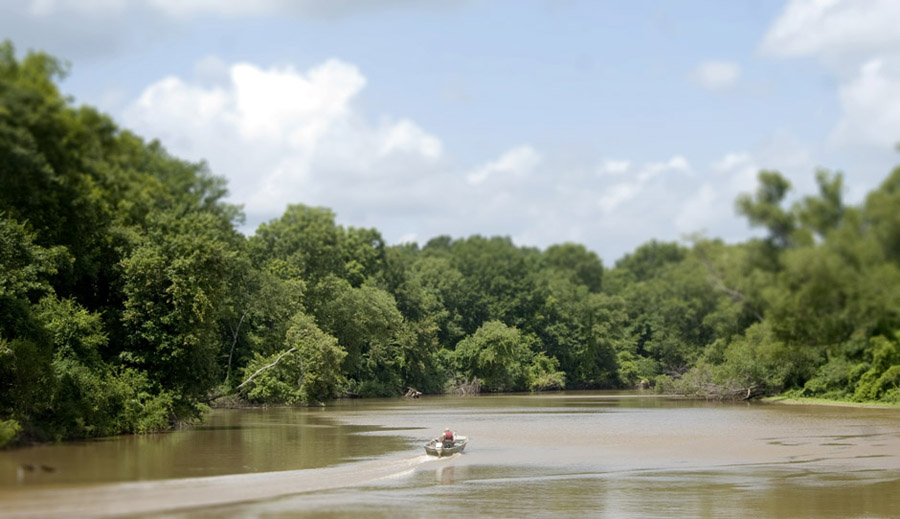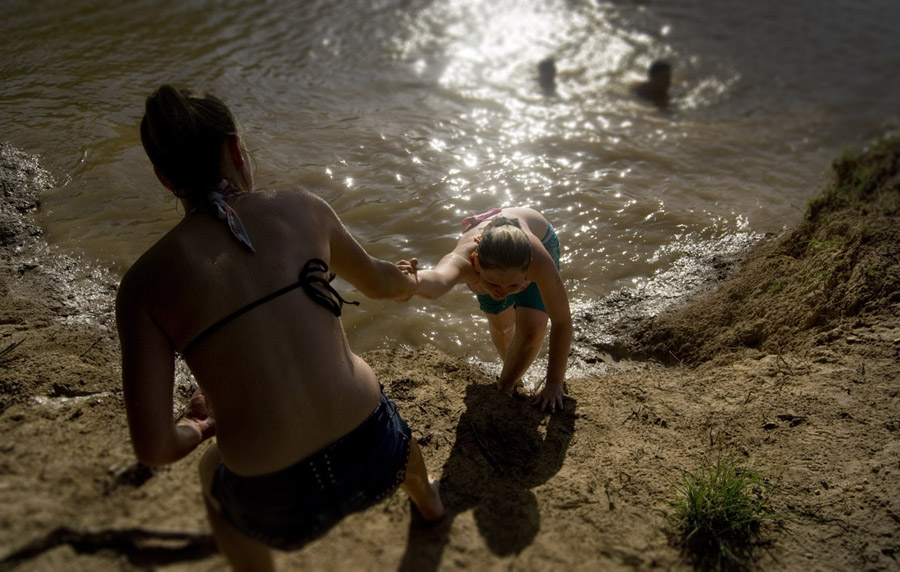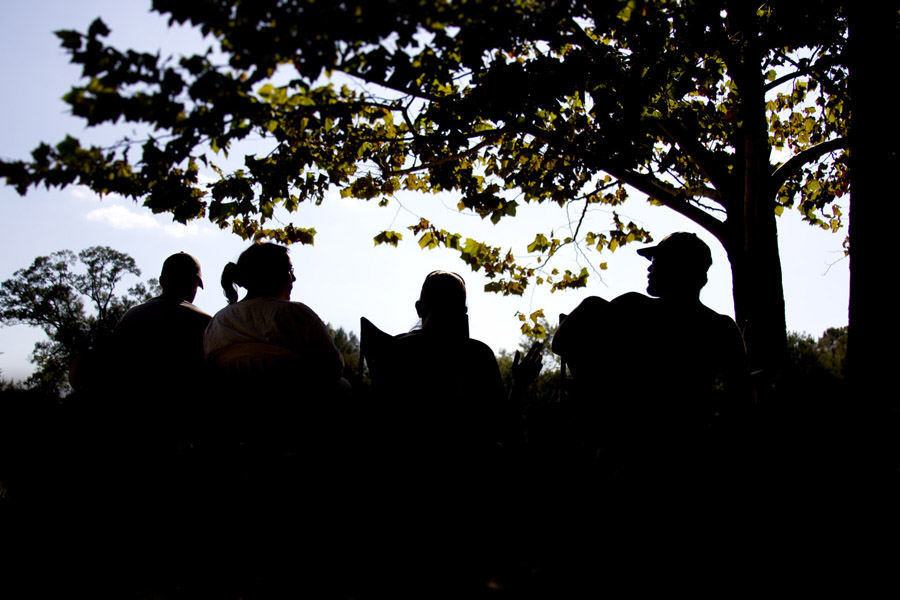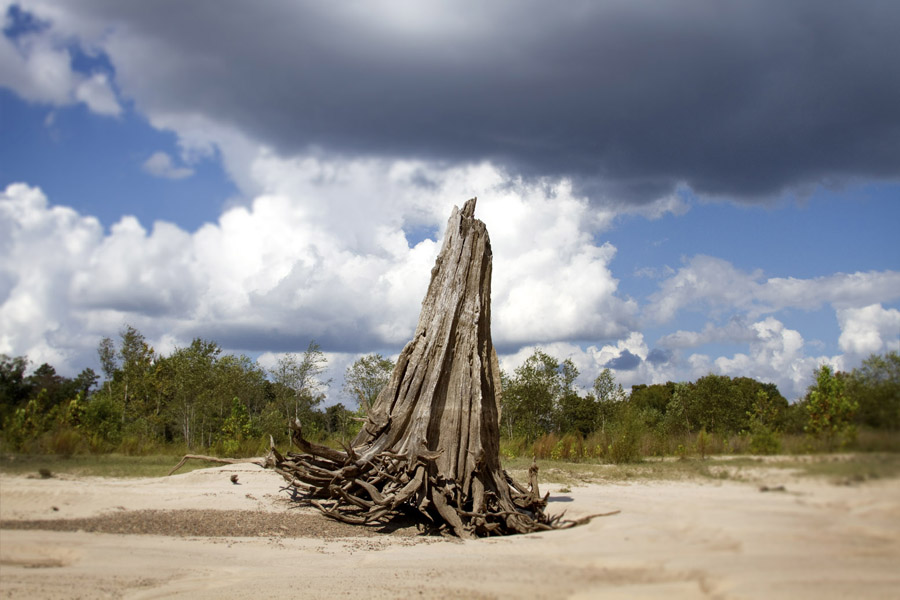Running the River:
Secrets of the Sabine
By WES FERGUSON
Photography by JACOB CROFT BOTTER
A man shot at us our first day on the river. Of course he did. You expect that sort of thing to happen on the Sabine.
I met Jacob at his father’s house early that morning. He hitched the boat to his truck, and we drove south and east into the border country where Texas blends into the forests and swamps of Louisiana. Jacob’s father, Henry, rode shotgun. You could tell he was nervous the way he chattered against the quiet. The boat belonged to him, and he was loaning it to us, but Henry swore he didn’t care about the aluminum sixteen-footer. He envisioned the gun-toting types who live along the river, the snags that capsize little boats, and the bewhiskered catfish lurking in underwater dens, and he couldn’t help worrying about his adult son. For distraction, he told jokes.
“Y’all gonna do any noodling on your trip, Jake?” Henry asked.
“I doubt it, Pop,” Jacob replied, his eyes fixed to the blacktop.
“You should; you really should,” Henry said. “Reach down in that river with your bare hands and yank a forty-pound catfish in the boat, and rednecks up behind the bushes will see y’all and say, ‘We’ve been watching y’all the past fifteen miles. Now you’re one of us. We’ll do anything you need.’” Henry was no fan of rednecks, though as I sat in the backseat watching the forests of longleaf pine trees blanket the East Texas hills, I suspected that more than a few people would classify us no more charitably.
We drove through heavy forest, where black creeks widened in the bottoms, their waters issuing imperceptibly toward the Sabine. The eighth-longest river in Texas, flowing almost entirely within the Piney Woods region on the far eastern edge of the state, the river swells to nearly four hundred yards wide near its mouth at Sabine Lake—no less than half the width of the mighty Mississippi at the Canal Street ferry in New Orleans. The Sabine appears less imposing upstream, however. Where I am from, the river is muddy and narrow and full of debris. In 1779, a Frenchman named Don Athanase de Mézières warned of its “frequent and dangerous turnings” and reported, via letter dated at the ferry crossing of the old Camino Real, “There is no other river that affords greater obstacles.” What’s more, from the earliest days of Anglo settlement in Texas, the Sabine has earned a reputation as a no-man’s-land and a haven for outlaws fleeing justice on both sides of the state line.
Some say not much has changed. But Jacob and I had survived our previous encounters with the Sabine. We had been captivated by the upper river’s solitude and subtle beauty and the self-described river rats who hunt, fish, and swap stories beside the muddy water with little concern for polite society on higher ground. Now the two of us intended to boat down the rest of the river where it charts the boundary between the states. We knew next to nothing about traveling the lower Sabine, except that along the way the sun would rise in Louisiana and set in Texas, and we would fish, camp on sandbars, and explore a section of the river that was unknown to us—and to most people. The border region was set to be exceedingly remote and largely inaccessible to humans, crossed by few signs of civilization and populated by no more than a handful of mosquito-bitten timber folks and river rats, hunters, loggers, and the occasional black bear lumbering through the swamp oaks and cypress knees.
At midday the forests parted, and we arrived at the boat launch on the Louisiana bank. Then our trip almost ended before it began. We were gathering our gear and transferring it into the boat when an old man ambled toward us on his way to the concrete ramp. His fishing pole bobbed to the shuffle of his steps. He was a withered old fellow, a river rat, with a gray beard, cutoff jean shorts, and a head of scraggly white hair in need of scrubbing. The man stopped to inspect our nice, new boat, and then he inspected us. He didn’t like what he saw.
“Not planning to go very far?” the man asked.
Jacob and I glanced at our mounds of camping gear. Dry boxes packed with provisions, bed rolls, a tent, a couple of coolers, and two extra cans of gasoline filled the boat. Obviously we were well equipped for a weeklong expedition. Was this fellow being sarcastic?
“What do you mean?” Jacob asked.
“Are y’all not planning to go very far?” the man repeated flatly, his tone bracing for an argument. He picked at his beard and waited for a reply.
“Well, sure we are,” Jacob said. “We’re going all the way to the Gulf of Mexico.”
“Not in that boat you’re not!” the man declared. “Ain’t no water!”

I nearly dropped the ice chest I was holding when I swung to look at the river beyond the boat ramp. A tangle of scrubby green trees and bushes lined the opposite bank. The sheet of brown river water was saturated by mud, sand, and tiny particles of decaying trees and other plant matter. Then I noticed a more troubling sign. Large yellow spots dotted the water like submerged islands. Those spots, I realized, were sandbars lying just inches below the surface. He had a point. The river was low—very low.
“You won’t make it a mile,” the man continued. “I should know. I was raised on this river.”
He volunteered more bad news. Earlier that week, he said, a team of researchers from a place called “Texas University” had tried and failed to conduct a survey of the freshwater mussels that inhabit the Sabine. The river is full of the hard-shelled mollusks, with thirty-two species ranging from wartybacks to pigtoes. But the researchers were unable to navigate the low water and were forced to abandon their project. He told us that a couple of miles downstream from the boat launch, a solid pile of rocks obstructed the entire river. If we even made it that far—which he doubted—we would only be marooned on the rocks and would be forced to carry our boat overland.
Jacob’s dad was listening intently. “Say Jake, why don’t y’all call this thing off,” Henry said. “Come back another time.”
Jacob didn’t say a word. He walked down to the river to get a better look. There, two people rode four-wheelers on dunes where the river had receded to reveal a bright sandy beach. The roar of the people’s gas-powered engines carried through the still air.
By then I was ready for the doomsayer to mind his own business. Instead, he stood beside the boat, looking pleased with himself, and Jacob and I were faced with a very big decision. It was not an option to put in a little farther downstream. We wouldn’t come upon another boat ramp for sixty-five miles, and by then we would have bypassed more than half our journey. Jacob walked back from the beach. There was more talk of canceling.
As father and son deliberated the best course of action, carefully weighing risks and rewards, I felt a sense of panic growing inside me. We had been planning this trip for months. More than that, we were jeopardizing our effort to explore a river that is often overlooked, and sometimes maligned, but serves a vital role in the environmental health of the region. There was no way we could back out now; I was sure of that. But first Henry had to be convinced. I hatched a new plan.
“There’s a highway bridge only ten miles downriver,” I told him. “We’ll be there in a couple of hours. You could drive over and wait for us to come by, and when we do, we’ll let you know if we think we can keep going or not.”
This seemed to ease Henry’s mind a little. My next objective: to get the boat off the trailer and into the water. “Let’s take a test run so we can see for ourselves,” I said to Jacob.
He walked down to the river a couple more times, thinking it over in the October sun. We could hear the roar of the four-wheelers and the occasional redneck yelp, and eventually Jacob agreed to take a test run. We unloaded our supplies from the boat and backed it down the ramp and into the water, then eased our way downstream. I stuck my paddle into the water to gauge the river’s depth and struck bottom about two and a half feet below the surface—almost impossibly shallow. Soon, though, the paddle’s tip couldn’t reach the riverbed in the ever-deepening water. We passed a young fisherman who was trolling up the river toward the boat ramp. I asked him how far he had gone.
“About a mile,” he answered.
“You have any problems?”
“Not except that I hit a stump and broke my prop.”
A broken propeller posed a hazard for boat motorists any time of year. I was sitting at the front of the boat, and I turned around to face Jacob, to ask him what he thought.
“Let’s go for it,” he said.

We sped upstream to the boat ramp and hastily reloaded our gear before we could change our minds. Jacob had taken charge of the meals, and he packed enough food to last two weeks. As long as we didn’t sink the boat and no wild hogs discovered our cache, we would not go hungry. Jacob’s dad was more concerned that we would be stranded on one of the low places the old man had warned us about. “What if it gets to nightfall and I still don’t see you?” Henry asked.
“You’ll see us,” Jacob said.
Henry picked up a chunk of concrete rubble beside the boat ramp. He dunked the heavy block in the river to clean the mud away and placed it near the bow of the boat, beside my feet.
“If I’m not there when you get there,” Henry said, “leave the rock so I’ll know you went by.”
“Dad,” Jacob began to protest, but I immediately agreed to hold on to the piece of concrete. Anything to get us down the river.
When we set off again, the scrawny old man was squatting by the bank. We had ignored his advice, and now he was ignoring us. It occurred to me that I should stop and ask him a few questions, to hear more about his life on the Sabine, but at that moment I wanted nothing more to do with him. Our journey was under way.
The boat motor hummed. The wind cooled our faces, and sunlight danced on the river straight ahead. When the sun hit the water just right, we could see the fickle course of the narrow river channel, where the water flowed more swiftly and deeply than the rest. The channel appeared as a shadowy line below the surface, snaking from one side of the river to the other, a miniature version of the channels Mark Twain had navigated on the mighty Mississippi. It tended to hug the river’s outer bends, carving away the steep banks. Sloping sandbars formed a string of private sandy beaches along the lower inside bends.
An anonymous green thicket crowded the riverbanks, which varied from high and clifflike to low and swampy. We saw no houses or other signs of civilization, only trees and brush. Taking in my surroundings, I chose to ignore the difficult time Jacob was having as he steered our boat through the shallow water. The rudder kept thumping the riverbed, and each time the boat lurched to a stop.
We were better off when we stayed in the deeper channel but often lost sight of it under the shade of willows or oaks, and we ran aground. Other times the channel fragmented into a braid of smaller channels, and we slammed into a sandy bed. On these occasions I climbed out and tugged the boat into deeper water, drenching my boots and filling them with silt.
Because there were so many twists and bends in the river, it did not take long to stop noticing them, until we came around one that was taller than the rest. The high, far-off bluff created a kind of balcony where four people were sitting in a row of lawn chairs overlooking the water, as though they had purchased tickets to a matinee show. Come to think of it, the Sabine River was probably the only show on that lazy afternoon at the western edge of Louisiana.
I swear I’m not making up what happened next. We waved, and they waved back, so we decided to stop and visit for a moment. But just as we were pulling onto the sandbar beneath their bluff, a burst of gunfire exploded in our ears. The river plop-plopped behind us. A warning shot! The gunfire echoed across the water.
“Was that aimed at us?” I asked.

We ducked in our boat and froze, not sure what to do. Soon we heard a shout from the tall bluff: “Sorry for shooting at y’all! I thought you was my brother.”
Jacob shook his head and muttered, “I’m not sure that makes it any better.” Then he yelled to the people just out of sight, “Can we come up there and talk to y’all?”
They didn’t answer, so I hollered louder: “Hey! Can we come talk to y’all?”
“Sure!” they replied.
The voices sounded friendly. Not like the kind of people who would shoot a trespasser on sight. I scrambled up the loose dirt bank and introduced myself. To my surprise, they knew who I was, having read a series of stories I had written about the Sabine River for the newspaper in Longview, a three-hour drive to the northwest.
“I was wondering when we’d see you down here,” said the shooter, a shirtless man named John Flack. Tattoos adorned his arms and chest, and his jeans were tucked into his boots. A .22 rifle lay across his lap. “Sorry for shooting at y’all,” he repeated. “My brother has a boat just like yours.”
“That’s okay,” I replied, not wishing to offend a trigger-happy stranger. “What have y’all been up to?”
“We was out here shooting turtles,” said his wife, Kathy. “I got one.” Then she gestured toward her husband. “He ain’t got nothing.”
“I shot three!”
Their children could be heard playing and laughing at a house that sat farther inland from the bluff.
“It’s peaceful out here,” John said.
“Till you decide to start shooting everything,” his wife corrected.
Their friend Corey Ducote looked at me and chuckled. “I can’t believe y’all got shot at your first damn day on the river,” he said.
We visited for a minute, long enough for Jacob to take a few photographs, but we couldn’t stick around because Henry was still waiting for us. When we came to the highway bridge, near the tiny unincorporated lumber town of Bon Wier, Jacob’s dad was sitting on a fallen log in the shade. He had been waiting for three long hours. “Some redneck was trying to talk to me,” he grumbled. Henry had explained that his son and a friend were traveling downriver from the previous boat ramp, around ten miles upstream.
“That’s a long way,” the man replied. “Took us eight hours in an inner tube.”
Floating the muddy old Sabine in a tube? That was too much.
“I told him, ‘I don’t even want to talk to you.’”
The evening sun cast long, slanting shadows from the bridge. Henry grabbed the chunk of concrete rubble from the boat and tossed it onto the bank, and after extracting a promise from Jacob to call him every couple of days, he said good-bye and pushed us away from shore.
Excerpted from Running the River: Secrets of the Sabine, published April 5, 2014, by Texas A&M University Press.
